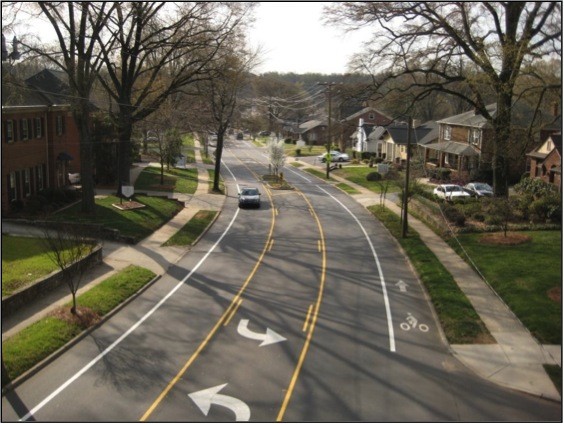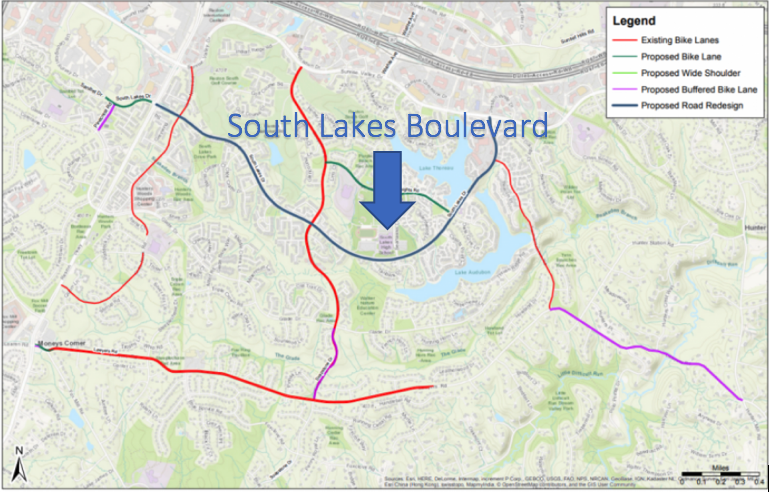Fairfax could get new bike lanes and road diets this summer. Not everyone is happy.

These bike lanes in Charlotte, NC are a good example of a complete street that Fairfax wants to build more of. Image by Complete Streets licensed under Creative Commons.
Fairfax County plans to add bike lanes or sharrows (shared lane markings) to 44 streets this summer. The “road diet” and improved bicycle infrastructure could help reduce collisions and improve safety, but not everyone is on board.
Repaving and brand new bike lanes
Each year, Fairfax County works with the Virginia Department of Transportation's (VDOT) repaving schedule to find out what roads could be repainted to include bike lanes after the repaving is done. It's a good system for getting bike lanes in quickly and cheaply.
Since the repaving is already on the books as part of regular maintenance, the ability to paint in bike lanes is easy and the cost is trivial. Doing so has allowed the county to add about 140 miles of bike lanes over the past couple of years.
One drawback is that since the work is coordinated with Virginia Department of Transportation which sets its own schedule, it can take awhile for gaps to be filled in the county's nascent but growing bicycle network. Another drawback is that Fairfax can't really tackle big problems with pavement and paint, so major problems that need to be addressed cannot be fixed as quickly.
Still, now that the program is in its tenth year, we are seeing the growth of a bike lane network across the county. That was the case last year in Annandale, and now this year Reston is improving too. However, its proposed road diet for South Lakes Drive has drawn some opposition.
The list of roads possibly getting bike lanes this year. Image by the author.
Successful road diets are still controversial
Sometimes the repaving allows the county to do more than just bike lanes. Sometimes a four-lane road that does not have turn lanes or bike lanes can be converted into a two lane road with bike lanes and space to turn. Known as a “road diet,” it is a good way to help make a road safer without making congestion worse.
Fairfax County is proposing a road diet for South Lakes Drive. Right now, South Lakes is a four-lane road between Reston Parkway and Sunrise Valley Drive. Chris Wells, the Pedestrian and Bicycle Program Manager for Fairfax County, laid out the case for a road diet. He says on South Lakes Drive the speed limit varies between 35 and 40 mph, but the average speed usually hovers closer to 45-50 mph.
The road also has a higher-than-average number of collisions, especially for vehicles turning left out of various neighborhoods (like mine) onto the road.
South Lakes today. Sidewalks only run along one side of the road at parts. Image by the author.
Meanwhile, parts of the road still lack sidewalks — despite the road serving several residential communities, schools, retail, and regular bus service. There are trails nearby, but they are unlit and steep in some areas. South Lakes Drive is relatively flat.
While the road sees around 8,000 cars per day, the threshold for roads that are good candidates for road diets hovers around 20,000 cars per day (though Fairfax County stops at 15,000). Even at rush hour, the road is rarely congested. The only backups occur specifically when South Lakes High School's school day begins and ends.
Proposed bike lanes for South Reston. Image by Fairfax County.
Despite all this, there is still some stiff opposition to the idea. At a recent public meeting about two thirds of the attendees raised their hands when asked if they came specifically because they did not like the idea of a road diet for South Lakes. The idea that you could take a four-lane road and make it two lane roads without impacting trip times simply seems like it won't work.
Lawyers Road already shows us the way
Arguing for a road diet would be more of a challenge if there wasn't a national model for a successful one already in Reston: Lawyers Road, which roughly runs along the southern border. It was a four-lane road until 2010, when it was reconfigured to have two travel lanes, two bike lanes, and a center turn lane.
It was a wild success. Rear-end collisions and extreme speeding were virtually eliminated along the road, while trip times did not increase. Lawyers road is now a national model for how road diets can improve safety for everybody (drivers included) without slowing anyone down. Anyone wondering about what a road diet on South Lakes would be like doesn't even have to travel more than a mile or two.
South Lakes might get a road diet and would follow the example of nearby Lawyers Road. Image by the author.
Since then, two more roads (Colts Neck Road and Soapstone Drive) that cross South Lakes Drive have also gotten road diets, and the results have largely been the same. While communities in the north of Reston have the W&OD trail to make quick connections from the east to the west, there isn't really a good connection for south Reston. South Lakes could be that connection.
As someone who has to use South Lakes to get anywhere, that is something I'm excited about. Most of my bicycle trips would be shorter and safer. When I choose to drive, I would be able to make a left turn out of my neighborhood without praying that no one is speeding around the large curve. My trips on the bus would stay the same because the road is rarely congested even when school is starting. Also, my bus is full of students who would also be safer biking, if they wanted to do that instead of ride the bus.
Lawyers Road today. It used to be four lanes like South Lakes today. Image by the author.
Still, opposition could stop the project dead in its tracks. At the public meeting about the proposal, concerns ranged far and wide.
Some comments were reserved, focusing on how to deal with the challenge of the school day or asking why bike lanes might be built before sidewalks are completed along the length of the road. Those are real challenges, and may impact final designs. School drop-off is difficult no matter what, and the construction involved for new sidewalks is a much bigger and more involved construction project compared to this road diet, which will be bundled with the regular repaving.
Image by Fairfax County.
But then Fairfax County bike planners were accused of taking bribes from Capital Bikeshare, for wanting people to be harmed from slowed emergency vehicles, and letting cyclists use Reston as a “Velodrome” while at the same time wasting money on bike lanes that “nobody uses.” Other people were frustrated that it might be harder to pass school buses.There were also accusations that the county has not provided enough notice for the well-attended meeting.
Still, the facts support a road diet for South Lakes because it would be safer for everyone while not impacting travel times. It would be a huge step forward for a county that is working to complete tons of backlogged pedestrian and bicycle infrastructure, including plans to expand Capital Bikeshare to south Reston.
One of the participants at the meeting who supported the bike lanes made the point that there “[still] room for all of us” with the South Lakes road diet. South Lakes has the potential to be one of Fairfax's great successes in creating complete streets — but only if we don't let congestion fears stop us from making our roads safer for everyone.
